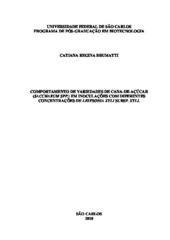Comportamento de variedades de cana-de-açúcar (Saccharum spp.) em inoculações com diferentes concentrações de Leifsonia xyli subsp. xyli.
Resumen
The sugar cane is a semiperennial plant currently considered one of the most important crops in the world due to its ability to produce renewable energy (ethanol) and sugar. The soil quality, water availability and temperature are the main effects that made Brazil the largest producer. However some factors influence the sugarcane productivity, mainly diseases. Among them we can cite the ratoon stunting disease caused by the bacteria Leifsonia xyli subsp. xyli worldwide known to cause up-to-30% losses in the productivity. The spread of infected seedlings and the absence of external symptoms make it difficult to diagnose and require the use of laboratory techniques. Thermotherapy, cutting-material cleaning with detergent solutions and the use of resistant varieties are the key measures to contain the disease. Due to its easy spread and high rates of reduction in the productivity the objective of this study was to evaluate how the effect of four different concentrations of Lxx for four cuts, would affect the interaction varieties x cuts x bacterial concentration. Therefore it evaluates possible losses on the technological variants and the reliability of Dot blot test for the PCR from DNA extraction according to the protocol of CTAB. The analyzed data showed no significant reduction in varieties productivity in none of the four different bacterial concentrations including the control plants, as well as in technological variables on study. According to data the Dot blot technique was more sensitive than the PCR conditions utilized in this study.
